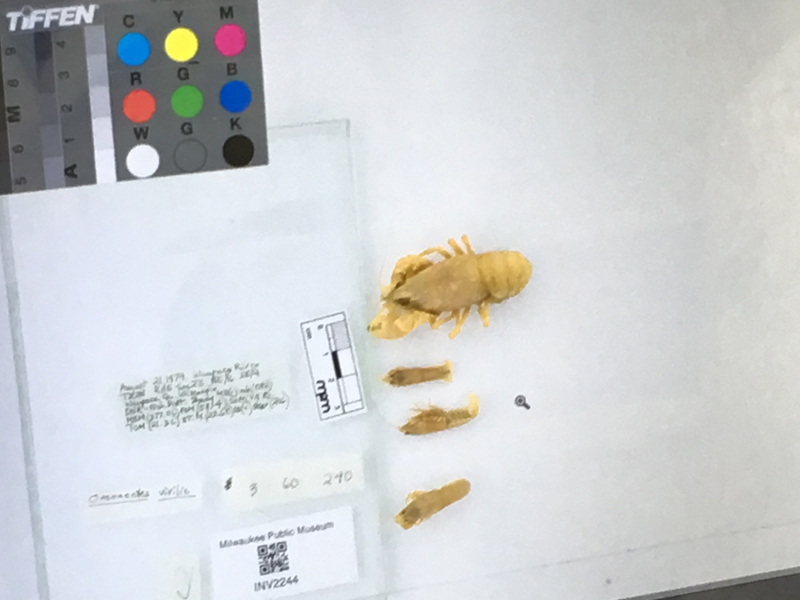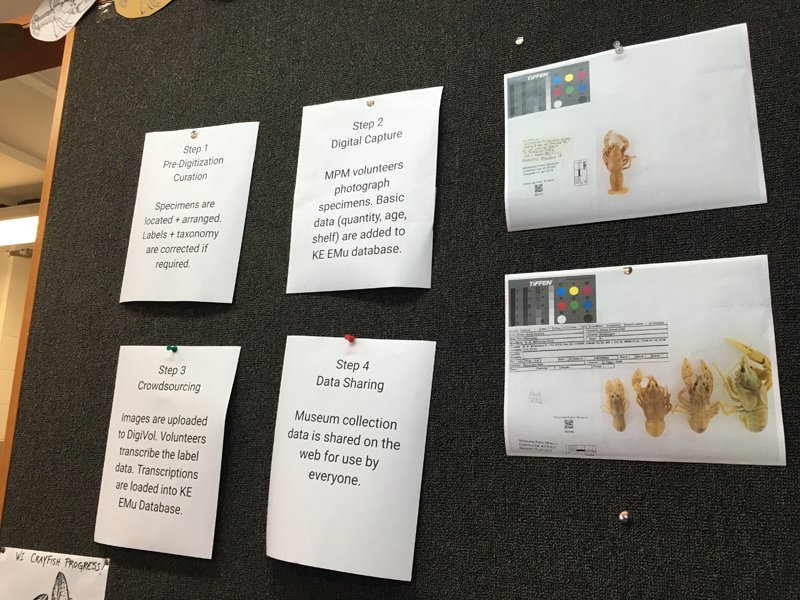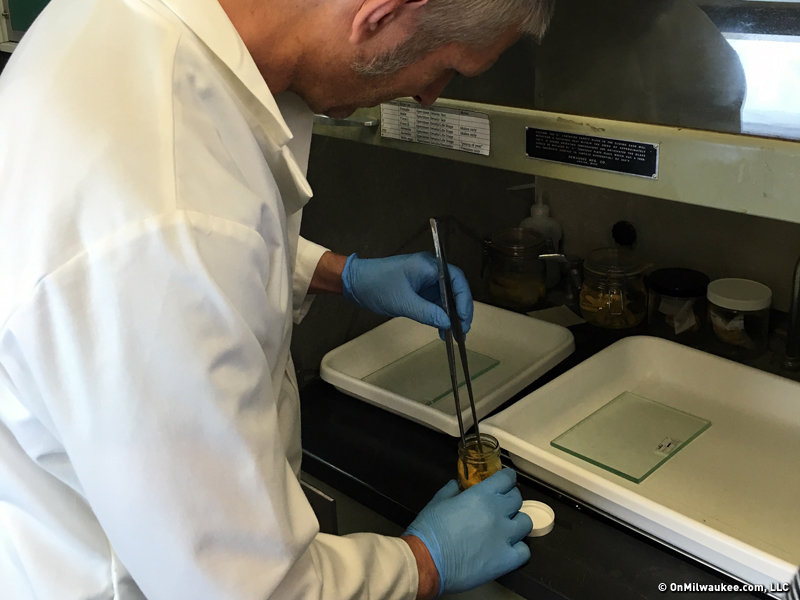You know the old saying, "it takes a village." Well, that village is what’s currently fueling the Milwaukee Public Museum’s push to get its vast collections digitized and online. That and some funding, too, of course.
"Digitization has actually been happening at the museum, but this is a major grant that we got from a donor to start up a number of endeavors here at the museum," says Zoology Collections Manager Julia Colby. "The digitization project is actually with the idea of starting a sustainable, actual program at the museum to digitize our collections."
Colby and Collection Digitization Project Manager Alyssa Caywood – whose position was created and funded by the grant money from Chris Rundblad and Lynn Chappy – have been overseeing a team of volunteers in Milwaukee who are scanning collections, including a large grouping of Wisconsin crayfish. The scans are uploaded to a web site, where volunteers in Australia have been working to input related data.

The result is a growing portion of MPM’s collections online for everyone – but especially scholars and scientists – to view and use for free.
The museum has received funding for two years, during which time it aims to digitize 75,000 of the 4 million objects in its collections. To continue what is eyed as an ongoing project, ongoing funding must be secured.
"It's very important to digitize natural history collections, because a lot of our collections are like these crayfish, where you have the physical evidence from past science together with label information, but it's not very accessible," says Colby. "We are choosing collections that have no digital footprint at all."
Colby selects the specimens to be scanned and brings them to the scanning area, where volunteers, overseen by Caywood, open each specimen jar, arrange the contents – including descriptive labels – onto a tray and make the scan. The volunteers also enter some information, and keep a log of what has been scanned.
On a good day, a pair of volunteers – one manning the computer and the other donning rubber gloves to handle the specimens – has been capturing upwards of 75 specimens a day. That sounds impressive, but it’s a tiny fraction of a fraction of the seemingly countless objects in the museum’s collection.
And, sometimes the Australian volunteers – who are being coordinated via the Australian Museum and the Atlas of Living Australia – are logging so many hours that the scanning team can barely keep up.
"By blocking it out in little chunks, we share the work over a number of different people and then end up with a complete record," says Colby. "Once we have a complete record, eventually we have a complete collection.

"That collection's data can actually be shared with other institutions across the world. Scientists can get ahold of our data much more readily. They can ask more complex questions, because you're not just rebuilding with the data in these a snapshot of one particular critter. If you use this with the fish data that was collected from the same locations or other plants and animals, you can rebuild a picture of what that space was like at that particular time."
Though the museum has done some digitization in the past, Colby and Caywood say that this new push is getting the work back on track.
"I think we are a little behind the curve," says Colby. "We have done little chunks of stuff. We do a part of this collection or a part of this collection. That's just not a sustainable way to do it. We were ahead of the curve, then we fell off the curve, and now we are back on the curve."
The renewed effort will bring the museum more in line with trends in the museum community, says Colby.
"It's a huge push right now in the museum world," she says. "There's a bunch of big initiatives regionally and nationally to share that data. We needed to be part of that."
Caywood says she’s been amazed by the response from volunteers, both here and in Australia, some of whom are cranking out work at no cost to the museum.
"We were pretty astonished," Caywood says. "It's very much driven by individuals who are very dedicated to this. You just need one person who just decides they are going to spend an evening spending time with your crayfish. They will just spin through those labels and you come in the next morning, and you're like, ‘okay, wow’."
"That's gratifying and terrifying at the same time," says Colby, "because it's exciting that you can put this out there in the world and people are interesting in doing it. It shows how many people out there in the world want to make a meaningful contribution to science."

Now, Milwaukee Public Museum is turning its focus to getting Milwaukee more involved in the program.
One step has been to team up with students from St. Joan Antida High School on the city’s lower East Side to come in and do some scanning work.
Another way is the museum’s upcoming DataBlitz! event on Saturday, Oct. 22, from 11 a.m. until 3 p.m.
Museum visitors can lend a hand by transcribing data from the collections. Folks who participate in the blitz for at least 60 minutes will get free museum admission.
"This is an exciting thing for us, because it's not just a way to get our local community involved with the collections in a new way, but we are able to broaden the communities out there that can actually see what we've got here," says Colby.
"Eventually, we'd like this to be scalable," adds Colby, who notes that less than 5% of the museum’s collections have been digitized so far. "If we want to do everything, which we do, that is a project that's easily going to outlast the two of us."
Born in Brooklyn, N.Y., where he lived until he was 17, Bobby received his BA-Mass Communications from UWM in 1989 and has lived in Walker's Point, Bay View, Enderis Park, South Milwaukee and on the East Side.
He has published three non-fiction books in Italy – including one about an event in Milwaukee history, which was published in the U.S. in autumn 2010. Four more books, all about Milwaukee, have been published by The History Press.
With his most recent band, The Yell Leaders, Bobby released four LPs and had a songs featured in episodes of TV's "Party of Five" and "Dawson's Creek," and films in Japan, South America and the U.S. The Yell Leaders were named the best unsigned band in their region by VH-1 as part of its Rock Across America 1998 Tour. Most recently, the band contributed tracks to a UK vinyl/CD tribute to the Redskins and collaborated on a track with Italian novelist Enrico Remmert.
He's produced three installments of the "OMCD" series of local music compilations for OnMilwaukee.com and in 2007 produced a CD of Italian music and poetry.
In 2005, he was awarded the City of Asti's (Italy) Journalism Prize for his work focusing on that area. He has also won awards from the Milwaukee Press Club.
He has be heard on 88Nine Radio Milwaukee talking about his "Urban Spelunking" series of stories, in that station's most popular podcast.







